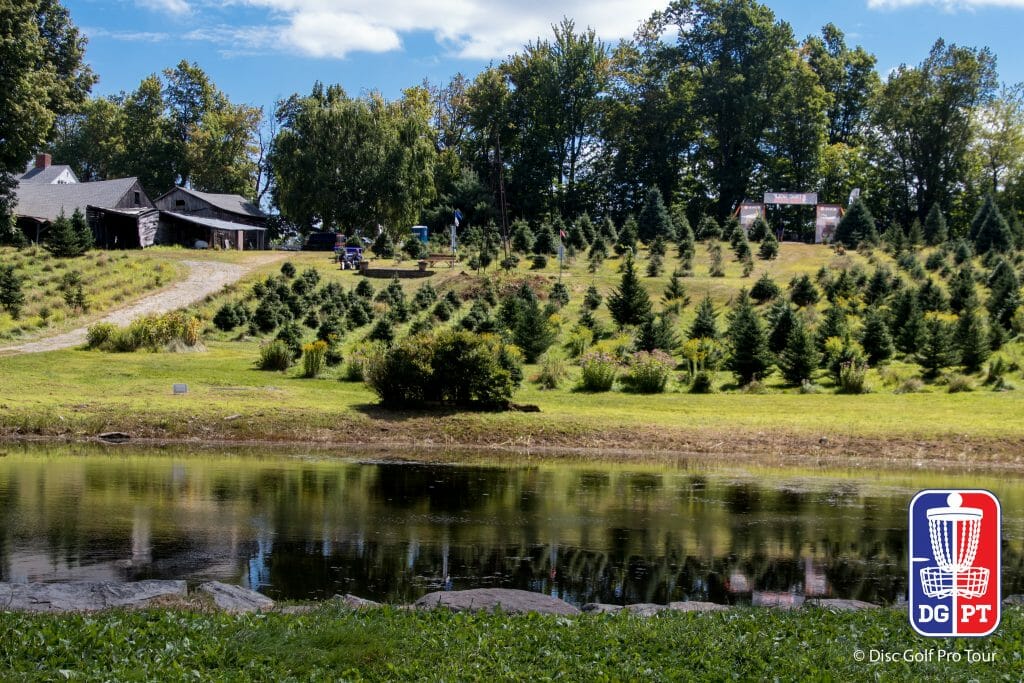Comparing Maple Hill's opening hole to Lake Eureka's at Ledgestone
August 28, 2018 by Patrick Aubyrn in Coverage, Opinion with 0 comments

On Circle M1nday I spent some time honing my stroke from close range, now it’s time to step back for a longer bid on Circle 2uesday.
I don’t own many DVDs these days, but two that survived the great purge of 2016 are the 2004 and 2005 Marshall Street Disc Golf Championship videos. What can I say? I love watching tournament coverage from Leicester, Ma. And as courses go, Maple Hill Gold is the crown jewel of the Disc Golf Pro Tour. For starters, I can’t think of a better opening hole on tour these days than hole 1 at the Christmas tree farm.
I don’t know if Nate Heinold had Maple Hill Gold on his mind when he designed the temporary track at Lake Eureka but I couldn’t help but recall the eighth DGPT tour stop in Illinois while watching the coverage this past weekend, especially during hole 1. Boiled down: to card the opening birdie on either course, you’ve got to huck a big drive over water and then throw a touchy approach into a green with O.B. menacing the pin.
I wondered, “which is harder?” More accurately, “how do these two holes measure up statistically?” More importantly, “does it matter?” If difficulty alone were the measure of great courses, we could literally ‘magic’ courses into existence anywhere we like or have permission to, fancifully conjuring them through artificial means. Recall the topic of conversation that constantly threatened to derail the DGPT roundtable on basket size: course design. We want courses to challenge the top pros and be visually appealing for players and spectators alike.
Let’s start with a quick foray into the numbers. Sixty-two players rated over 1000 registered for both the Ledgestone Insurance Open and the MVP Open.1 I prefer to limit my sample because the whole field doesn’t accurately reflect the touring pro. Over the course of four rounds, the first hole in Peoria averaged 0.24 strokes under par for the four-digit crowd, whereas the first hole at Maple Hill averaged 0.03 strokes under par over three.
What’s remarkable to me is that despite the relatively minor scoring differential between the two holes, a mere 0.21 strokes, the birdie rate at Lake Eureka virtually doubled what we saw at Maple Hill. More numerologically intriguing, the birdie and par rates basically flip-flop: Lake Eureka averaged 32.25 birdies per round and 15.5 pars whereas Maple Hill averaged (exactly) 15 birdies per round and 36.67 pars per round. Scoring was so similar because the bogey rate was two strokes lower in Leicester and double bogeys+ were more numerous in Peoria.
#1 at Maple Hill requires greater precision on both the drive and the approach than its Midwestern doppelgänger. Placement off the tee is crucial to attack the gap into the peninsula green. The play at Lake Eureka? Crush one over the dam to wherever you like, just don’t go O.B., then toss your approach up and into the hillside short of the pin, using it as a backstop.
Those who know me and like to chat about flying discs know that I do not like courses or holes that feel contrived. The triple mandatory hole 7 at Winthrop? Terrible. (We have holes like this at our most prestigious Major?!) The triple island hole 6 at the Disc Golf Values course in Vegas? Mini golf in masquerade. I also dislike the trend toward overabundant, visually artificial O.B. As a viewer, what’s worse than seeing a hole that plays into an open field where the fairway is defined primarily by flags, stakes, or ropes?
Taking the bird’s eye view of each course, Lake Eureka is your traditional park course on steroids and is (pretty clearly) modeled after Winthrop Gold. That is, it’s chock full of ropes, roads, and even a ball field for good measure. Maple Hill Gold, on the other hand, is an ultra-refined version of the woodsy, private course, replete with tight lines and an idiosyncratic charm reflecting its owners. It’s not lacking O.B. by any means, but it’s margins feel more integral to the property and the landscape.2 You could say, rightly, that it’s ‘of the land’ rather than ‘of the mind.’ The temporary course at Lake Eureka vanishes like Brigadoon following the Ledgestone Open—was it a real place?—whereas Maple Hill endures.
As disc golf continues to grow in visibility, I wonder if the Lake Eureka Temporary Course, and its older and more refined counterpart Winthrop Gold, should become relics of the past. I love the challenge each presents but I wish they had the championship caliber, natural beauty to match Maple Hill. I want the total package. Grit and glamour. Once I finish watching all of the 2018 MVP Open coverage, I think I’ll go fire up the DVD player and relive my college years, and the early days of the MSDGC.
However, only 61 finished at Ledgestone because James Proctor dropped out after the first round. But that’s neither here nor there. For all intents and purposes, the sample size is equivalent. ↩
Maple Hill includes plenty of ropes and advertising boards to deliminate inbounds and out-of-bounds areas, and from this, there are two takeaways. 1. They typically delimit actual differentiating features on the landscape (i.e. ponds, rock walls) and only occasionally make the foray into more contrived boundaries, like peninsula greens. 2. A pond’s edge or rock wall does not have a singularly defined boundary that is required for delimiting O.B. In these cases, boundaries necessitate markings on them to make rules decisions supported by the PDGA rule book. ↩